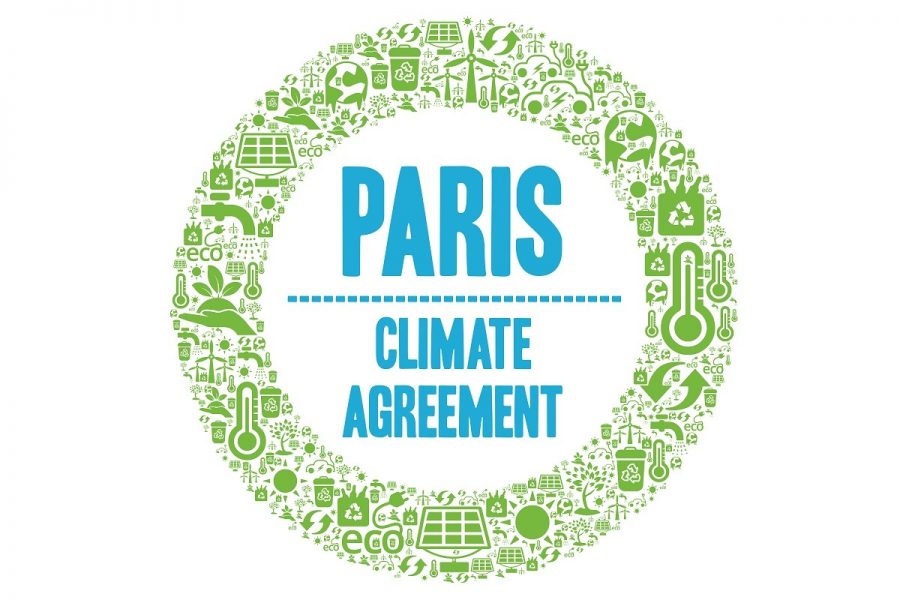The Paris Climate Agreement
February 23, 2021
With the new administration officially in office, the United States is going through changes. One of these changes is the re-entering of the Paris Climate Agreement, also referred to as the Paris Agreement. As stated in the name, the agreement focuses on the environment and lowering the amount of greenhouse gases in the atmosphere. Here is everything needed to comprehend the significance of this accord.
It is important to first understand what greenhouse gases are and why they are harmful. Greenhouse gases are gases that retain heat in the atmosphere. These gases are specifically carbon dioxide, methane, fluorinated gases, and nitrous oxide. The most prominent greenhouse is carbon dioxide making up 81 percent of the greenhouse gases in the United States according to the Environmental Protection Agency (EPA). The release of carbon dioxide is mainly caused by burning fossil fuels for things such as energy, transportation, and the production of goods. Types of fossil fuels include: coal, oil (petroleum), and natural gas.
The second most abundant greenhouse gas is methane. Methane is released through various natural and anthropogenic sources. The natural release of methane is found in wetlands and livestock feces. Anthropogenic or human-caused releases are found in landfills, coal mines, pipelines, drilling sites, and more. The release of methane is such a threat to the environment because even though it only made ten percent of the total emitted greenhouse gases in 2018 it is projected to have a twenty-five to thirty-four times greater impact than carbon dioxide. This is because it traps heat eighty-seven times more effectively.
Nitrous oxide is the third most prominent greenhouse at about seven percent of total emissions. It is produced mainly by anthropogenic actions such as agriculture, water management, and fuel combustion. Nitrous oxide is dangerous because like the other greenhouse gases it absorbs heat, but it also poses a second threat. If nitrous oxide is exposed to oxygen and sunlight, it converts into nitrogen oxides. Nitrogen oxides break down the ozone layer of the stratosphere which protects plants, animals, and humans from excessive ultraviolet light exposure.
The fourth and least abundant greenhouse gas are fluorinated gases. Fluorinated gases are unique in that they have no natural source. These gases are used as refrigerants, aerosol propellants, solvents, and foam blowing agents. They get released every time one uses their A/C or refrigerator. Fluorinated gases have a lifespan of thousands of years. With a lifetime that long, it has a very detrimental effect on the environment.
The main goal of the Paris Agreement is to lower the emission of greenhouse gases to keep the rise in temperature under two degrees Celsius or about thirty-six degrees Fahrenheit. To be able to even begin getting global warming under control, the Conference of Parties (COP) makes supporting undeveloped countries a priority in the agreement. When signing the contract, developed countries are agreeing to provide financial and scientific support for the countries that need it. The purpose of doing this is to have as many countries involved as possible despite their financial situation. Climate change and global warming are issues that cannot be resolved by one country, so the more countries that are involved the faster solutions can be found. The underdeveloped countries are also very heavily affected by climate change, so the assistance that developed countries can not only give them more opportunities to advance their science but also to make changes and adapt to their environment.
Another issue that the Paris Agreement focuses on is deforestation. Some may think that this is not necessarily relevant to the greenhouse gas emissions and control, but the high rate of deforestation is contributing to the high levels of carbon dioxide. Trees use carbon dioxide to go through photosynthesis and produce oxygen, so the extreme decrease in the number of forests is leading to a surplus of carbon dioxide. The agreement is trying to hold countries accountable for the amount of deforestation going on because not only is it causing a surplus in carbon dioxide it is also causing the loss of habitats and food for native species.
The Paris Accord emphasis that countries should cut down on actions that produce these greenhouse gases unless it affects food production. This is because a large source of methane comes from cows. A single cow releases between 70 and 120kgs of methane annually. With 1.5 billion cows and bulls worldwide, the food industry is responsible for 18 percent of greenhouse gas emissions. The COP made it very clear that the food production industry cannot be touched. This poses a challenge to scientists to find other areas to be able to cut down on without touching an industry that makes up nearly one-fifth of the total emissions.
An important area to cut down greenhouse gas emissions is the fossil fuel industry. Fossil fuels are a non-renewable resource that the United States along with other countries rely heavily upon. Petroleum is used for 37% of the United States’ energy. Moving towards renewable energy is something that will not only cut down on greenhouse gas emissions but will also help when fossil fuels eventually run out. Fossil fuels are materials that take millions possibly hundreds of millions of years to form. So at the rate of use, it is projected that fossil fuels will run out within the next fifty to one-hundred-year. If the energy industry does not start to shift towards renewable energy, they can be in serious trouble. Renewable energy comes from things such as windmills, solar panels, hydropower, and others. These resources are easily accessible and clean forms of energy.
It is time to take action and the first step for the United States is rejoining the Paris Climate Agreement. The USA official rejoined the agreement on Friday, February 19th, 2021. It is now one of the 197 parties that ratified the agreement. Some are still concerned that this is not a good move for the United States, but the effects of the agreement will be something that only time can tell.
The Paris agreement makes sure that countries put forth more of an effort than in the past. Climate change and global warming are things that are only getting worse, so the efforts that are already being made are simply not enough. When signing the Paris Agreement, countries are committing to putting forth more funding, better sciences, and assistance to the countries that need it. Global warming is something that cannot be solved in a year; it will be a slow process that will take time. As inhabitants of the Earth, people cannot put off climate change any longer.
Sources
EIA. “U.S. Energy Information Administration – EIA – Independent Statistics and Analysis.” Renewable Energy Explained – U.S. Energy Information Administration (EIA), 22 June 2020, www.eia.gov/energyexplained/renewable-sources/.
EPA. “Overview of Greenhouse Gases.” EPA, Environmental Protection Agency, 8 Sept. 2020, www.epa.gov/ghgemissions/overview-greenhouse-gases.
Melissa Denchak. “Greenhouse Effect 101.” NRDC, Natural Resources Defense Council, 23 July 2019, www.nrdc.org/stories/greenhouse-effect-101.
Moore, Lisa. “Greenhouse Gases: How Long Will They Last?” Climate 411, 26 Feb. 2008, blogs.edf.org/climate411/2008/02/26/ghg_lifetimes/.
National Oceanic And Atmospheric Administration. “Nitrous Oxide Now Top Ozone-depleting Emission.” ScienceDaily. ScienceDaily, 28 August 2009.
Powell, Tarika, et al. “Methane’s 20- and 100-Year Climate Effect Is Like ‘CO2 on Steroids’.” Sightline Institute, 9 Dec. 2019, www.sightline.org/2019/02/12/methane-climate-change-co2-on-steroids/.
Ritchie, Hannah. “How Long Before We Run out of Fossil Fuels?” Our World in Data, 8 Aug. 2017, ourworldindata.org/how-long-before-we-run-out-of-fossil-fuels.
Rohrer, Jürg. The Impact of Meat to Global Warming – Methane and co2. 13 Oct. 2019, timeforchange.org/are-cows-cause-of-global-warming-meat-methane-co2/#:~:text=A%20cow%20does%20on%20overage,like%20carbon%20dioxide%20(CO2).&text=Therefore%20the%20release%20of%20about,300%20kg%20CO2%20per%20year.
Shankman, Sabrina. “What Is Nitrous Oxide and Why Is It a Climate Threat?” Inside Climate News, 7 Dec. 2020, insideclimatenews.org/news/11092019/nitrous-oxide-climate-pollutant-explainer-greenhouse-gas-agriculture-livestock/.
“TAR Climate Change 2001: The Scientific Basis.” IPCC, 2001, www.ipcc.ch/report/ar3/wg1/.
UNFCCC. “The Paris Agreement.” Unfccc.int, unfccc.int/process-and-meetings/the-paris-agreement/the-paris-agreement.
University Corporation for Atmospheric Research. “The Greenhouse Effect.” The Greenhouse Effect | UCAR Center for Science Education, UCAR, scied.ucar.edu/learning-zone/how-climate-works/greenhouse-effect.






Nancy Huxman • Feb 25, 2021 at 11:21 am
I could not be prouder of all the research you have done on this paper. Your presentation was impeccable. This is a tool for true debate for the pros and cons.